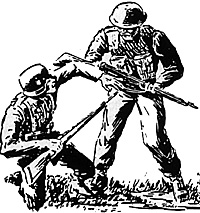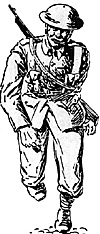 The short line of squaddies shuffled uncomfortably under their sergeant's critical eye, feeling oddly self-conscious with their blackened faces and cap comforters.
The short line of squaddies shuffled uncomfortably under their sergeant's critical eye, feeling oddly self-conscious with their blackened faces and cap comforters.
"Right, you lot. You know the drill. The CO wants to know what's on the other side of the valley, so we're going to have a shufti for him. All right? Any kit that can make a noise should be muffled or removed. None of you carrying any loose change? Leave your pay book and any other papers here. Any questions? Right, if any of you makes a sound, I'll have his guts for garters. Follow me."
Without another word, the patrol slipped silently through the forward defended location and disappeared into the darkness....
"Patrol activity" - it was a sort of news readers euphemism during World War 2 for "not a lot happening". The average infantry soldier, however, viewed this particular phrase very differently. The reconnaissance patrol was probably the most nerve-wracking task any of them had to perform. It meant crawling about in the darkness between the two armies, with no support to fall back on but their own wits, and the expectation that the silence could be shattered at any moment by a burst of enemy fire. The experience was universal; every nationality, in every theater of war, had their share of "patrol activity". The following game is based on this experience:
 Somewhere in France, 1944. Set the terrain on your wargames table to represent typical Normandy bocage: fields with high hedges all round, small orchards, walled farms, sunken roads, etc., etc.
Somewhere in France, 1944. Set the terrain on your wargames table to represent typical Normandy bocage: fields with high hedges all round, small orchards, walled farms, sunken roads, etc., etc.
One short side of the table represents the British front line; the other is the German base line. From the German base line, the table should be roughly divided into 4 bands, the depth of which will depend on the size of your table. My own is about 7 foot 6" by 4 foot 6", so I made the bands around 12 to 15 inches deep. It is obviously not vital that this is exact. Take an ordinary pack of playing cards and split them into the four suits. These will represent the German positions. Take six cards from each suit and place them, face down, as follows:
-
6 spades in the band nearest the German base line.
6 clubs in the next band.
6 diamonds in the next band.
6 hearts in the band nearest to the British lines.
Place the cards in locations were German positions could expect to be found.
You are a sergeant in your favorite British infantry division. You have 5 men, and you are all armed with a rifle and, if you feel the need, one grenade. Your task is simple - find out as much as you can about the German positions opposite, without raising the alarm. You start from any point on the British front line, and you have two and a half hours to find out what you can and get back. If you can bring back a prisoner, that would be even better.
Each table move lasts five minutes, which allows a good margin of time for stopping, looking and listening. You can move from 1 to 5 inches per move. (If a game of 50 moves sounds a lot, remember that you will often make multiple moves taking more than 5 minutes). When you reach a card, turn it over and refer to the tables.
| HEARTS | |
|---|---|
| A | Mortar or artillery OP, with telephone line to rear. |
| K,Q | Infantry OP, with telephone line to rear. |
| J | German sniper. |
| 7,8,9 and 10. | Area sown with S mines. |
| 6,5,4 and 3. | Nothing. |
| 2 | Patch of soft ground. |
| DIAMONDS | |
|---|---|
| A | German platoon CP. |
| K,Q,J | Dug-in machine gun post. |
| 7,8,9 and 10. | Slit trench, containing half a section of riflemen. |
| 5 or 6. | More S mines. |
| 4 or less. | Nothing. |
| CLUBS | |
|---|---|
| A | German company CP. |
| K,Q | Dug-in anti-tank gun. |
| J | Dug-in heavy machine gun. |
| 9 and 10. | German platoon stood down. |
| 7 & 8. | Slit trench containing 2 German riflemen. |
| 5 & 6. | German sentry. |
| 3 & 4. | Nothing. |
| 2. | Slit trench with one German soldier. |
| SPADES | |
|---|---|
| A | German battalion HQ |
| K | Camouflaged assault gun. |
| Q | Dug-in 88mm gun. |
| J | Mortar platoon at stand down. |
| 9 and 10 | Infantry platoon at stand down, receiving food |
| 8 | Two unmanned Nebelwerfers. |
| 6 and 7 | German sentry. |
| 5 | Transport lines. German lorries or horse drawn vehicles parked up |
| 3 and 4 | Nothing. |
| 2 | German soldier having "call of nature". |
DETECTION TEST
To take a detection test, throw a D10 ( 0 = 10),
-
+2 if approaching the German card from the German side.
-2 if you have a prisoner or wounded man.
+1 in the "spades" band (Germans less alert this far back)
If you throw the same or less than your movement rate, you have failed the test and been detected.
RESULTS OF ENCOUNTERS
Mines: Take detection test against your speed when reaching the card. If you pass, you notice the disturbed ground and go round. If fail, Oops! There is a sharp crack and a mine jumps in the air and bursts, scattering pellets in all directions. Then the balloon goes up. (See later.)
Sniper: Take detection test against your fastest speed over the last three moves. If you pass, you see the sniper before he sees you and can either avoid him or try to overpower him. If you fail, he sees you first and disappears. If you throw 1 or 2 on a D6, he alerts his mates.
Infantry or Artillery OP or CP: Take detection test against your fastest speed in last three moves. If you pass, you see them first and can pass by. If fail, they fire a flare and the Germans are alerted.
Soft ground: Takes you an extra ten minutes to negotiate.
Machine gun post: Take detection test against your fastest speed in last three moves. If you pass, you see and avoid them. If you fail, you hear the sound of the gun being loaded. You have one move to take cover, then the MG fires 1D6 bursts at you.
Slit trench: Detection test against your fastest speed in last three moves. If you fail, Germans challenge you. If you throw 1 on D6, a flare is fired and Germans are alerted. If not, you must wait three moves stationary until Germans assume they were mistaken. If you move in this time, Germans open fire.
Sentry: Take detection test against your fastest speed in last three moves. If pass, you can avoid sentry or try to overpower him. If fail, he challenges. You may try to overpower him, but alarm will be raised if you fail in first move. If you run away, he will fire and raise alarm on a 1, 2 or 3 on a D6.
Lone German in Trench Take detection test against fastest speed in last two moves. If you fail, he sees you. He is a conscripted Pole and insists on being taken prisoner.
German having call of nature: He is in no position to argue. You may take him prisoner if you wish.
Other German positions: Detection test against your speed when you reach card. If fail, you have been spotted by a sentry - action as above.
IF GERMANS ARE ALERTED.
If the Germans are alerted, flares are fired and two German machine guns open fire with D6 bursts at medium range. If you throw 1, 2 or 3 on D6, German mortars launch a "DF" - they fire half a dozen rounds at a pre-arranged target. (Decide on the possible targets and dice for which one the Germans choose - be honest!) If your morale survives this and you can carry on, you must wait stationary for half an hour for heat to die down.
MORALE.
 Test morale on any occasion you are fired at. Throw D6. If result is equal or less to the number of men you have had killed or wounded, you have failed. If you are in "hearts" band, make your way slowly back to British lines. In other bands, lie low until daylight, then surrender to the first German to come along. "For you the war is over!"
Test morale on any occasion you are fired at. Throw D6. If result is equal or less to the number of men you have had killed or wounded, you have failed. If you are in "hearts" band, make your way slowly back to British lines. In other bands, lie low until daylight, then surrender to the first German to come along. "For you the war is over!"
OVERPOWERING ENEMY.
Throw D6 for your man attempting to overpower enemy soldier:
-
+1 for each man helping (up to 2)
-2 if wounded
+2 if undetected by target.
RESULT
-
1 Oops! Your man is beaten to the ground, unconscious
2 Your man is beaten off
3 A scuffle ensues, try again
4 German is still struggling, but isn't making a noise.
5 German beaten to ground, +2 next time.
6 Target goes all limp. Find a bush to hide him under
WIN OR LOSE
How to adjudicate whether you have succeeded? Well, first of all you have to get back - it doesn't matter how much information you have if you don't get to tell anyone. If you return with a prisoner and have located 5 or more enemy positions ( not including solitary sentries or snipers) your mission is a success. With no prisoner, you must be able to mark 10 German positions.
OR ALTERNATIVELY...
Bite the bullet and organize a company strength attack, based on what you have discovered. Company objective is to reach the German base line. Each prisoner you have brought back will allow you to turn over 1D6 cards. Give your platoons lines of advance and objectives. Request preliminary bombardment by artillery or mortars if thought necessary. When your plans are made and orders issued, turn over the remaining German cards.
And there you have it: not too serious a game, but one with a very serious military operation in mind. Apart from which, it is nice to have a World War 2 game which isn't dominated by those horrible greasy tanks!
Recommended reading:
Battle! by Kenneth Macksey. (Which gave me the idea!)
The Sharp End of War, by John Ellis.
The British Army in WWII, by the US Department of Defense.
Back to Table of Contents -- Lone Warrior #120
Back to Lone Warrior List of Issues
Back to MagWeb Magazine List
© Copyright 1997 by Solo Wargamers Association.
This article appears in MagWeb (Magazine Web) on the Internet World Wide Web.
Other military history articles and gaming articles are available at http://www.magweb.com
